If you want to start a meaningful conversation over cold email, you have to give the recipient a really good reason to hit the respond button. In other words, you need to start a conversation to which they can actually contribute. Whether it’s highlighting a benefit you know the other person will need or posing a question they won’t read elsewhere, an effective message is all about the potential client and building a relationship with them.
This is not the strategy this company took with its recent cold email:

There are a number of mistakes littering this email, but three in particular illustrate just how unlikely it is this message will start a meaningful conversation. Let’s take a look at what went wrong and what can be done to to fix the mistakes.
1. The subject lacks any real information.
At first I thought I read the subject line wrong; it’s just the sender’s name and a reference to LinkedIn. Unfortunately, it seems this tactic was intentional.
A subject line is the first impression you make with the recipient. It’s the point at which they decide whether to open your email and keep reading or trash the message altogether. Simply stating your name could work if you’re a household name (“Taylor Swift via LinkedIn”). Since most of us aren’t, though, the person on the other end of the email won’t have any idea of who you are, making this approach to subject lines completely ineffective.
The Fix: Lure the reader in with a benefit or interesting question. For example, a line like “recapture the deal you lost” is intriguing enough to pique someone’s interest but mysterious enough to make them want more. This ups the chances your email will stand out in a crowded inbox and that the recipient will open it.
2. The email is too self-focused.
Focusing on yourself rather than the reader is one of the worst blunders you can make in a cold email. Every paragraph of this sender’s email begins in first person, making them seem more concerned with promoting their business than solving the recipient’s pain points or learning more about them. Not only is this a huge turnoff, it also suggests you don’t understand or care about the other person’s business.
The Fix: Focus on aspects of your product or company the reader will find useful. They’ll be more likely to trust and engage with you when they see it’s not a one-sided conversation. A good copywriting trick is to always write in the second person, as it will help both you and the reader feel like you’re engaged in a two-way dialogue.
3. A lack of personalization makes the message boring.
To be successful, every sales email needs personalization—tailoring an email specifically towards a particular person or role. It makes the email more enticing to the recipient and also also signals that you’re familiar with that person’s business, or, at the very least, that you’ve done your research.
This email contains pretty much zero personalization. Sure, the sender included some tactics that could possibly benefit the reader, such as offering an on-demand team of software engineers. But that’s an overly broad benefit any number of potential clients could benefit from. Everyone needs on-demand software engineers these days, after all. There’s only one place benefits like these go: straight to the trash bin.
The Fix: Include details that are relevant to the recipient. That might include a known pain point or some recent industry news that will impact them. At the very least, this sender could have mentioned a post the recipient recently shared. Putting your reader at ease with these kinds of details is the simplest way to entice them and get them to respond.

